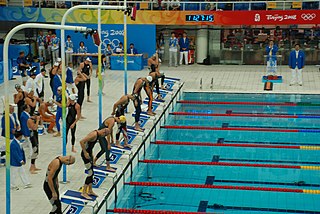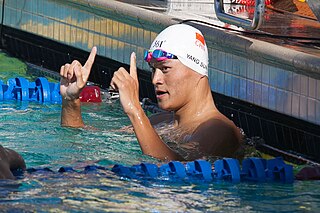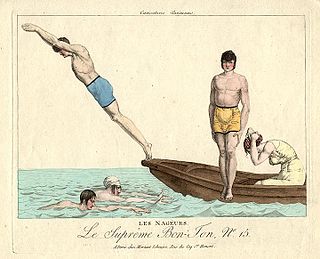
A swimsuit is an item of clothing designed to be worn by people engaging in a water-based activity or water sports, such as swimming, diving and surfing, or sun-orientated activities, such as sun bathing. Different types may be worn by men, women, and children. A swimsuit can be described by various names, some of which are used only in particular locations or for particular types of suit, including swimwear, bathing suit, bathing attire, swimming costume, bathing costume, swimming suit, swimmers, swimming togs, bathers, cossie, or swimming trunks, besides others.
Speedo International Limited is an Australian-British distributor of swimwear and swim-related accessories based in Nottingham, England.

Competitive swimwear refers to the swimsuit, clothing, equipment, and accessories used in the aquatic sports of swimming, diving, synchronized swimming, triathlon, and water polo.
High-technology swimwear, or tech suits, are scientifically advanced materials used for swimwear in competitive water sports such as swimming and triathlon. Materials of this type are normally spandex and nylon composite fabrics with features to reduce drag against the water. The fabrics include features that increase the swimmer's glide through water and reduce the absorption of water by the suit as opposed to regular swimsuits. Additionally, the suits are extremely tight, which make the swimmers body more streamlined and help reduce the buildup of lactic acid in the body.
The 2009 World Aquatics Championships or the XIII FINA World Championships were held in Rome, Italy from 18 July to 2 August 2009. The 2009 Championships featured competition in all 5 aquatics disciplines: diving, swimming, open water swimming, synchronised swimming and water polo.
The swimming competitions at the 2008 Summer Olympics took place from 9 to 17 August 2008 at the Beijing National Aquatics Centre. The newly introduced open water marathon events (10 km) were held on 20 and 21 August 2008 at Shunyi Olympic Rowing-Canoeing Park.

This is a history of the progression of the World Record for the Swimming event: the 200 Freestyle. It is a listing of the fastest-time-ever swum in the event, in both long course (50m) and short course (25m) swimming pool. These records are maintained/recognized by FINA, which oversees international competitive swimming and Aquatics.

Paul Biedermann is a German retired competitive swimmer, a 200 and 400 metre freestyle long course world champion. He holds the long course and short course world records in the 200 meters freestyle, and the long course world record in the 400 meters freestyle.

The LZR Racer is a line of competition swimsuits manufactured by Speedo using a high-technology swimwear fabric composed of woven elastane-nylon and polyurethane. The swimsuits are made in body-length; they compress the body and trap air for buoyancy. The LZR Pro and LZR Elite were launched on 13 February 2008; the higher-priced LZR Elite was replaced by the LZR Elite 2 in early 2014. The LZR X was launched in early 2015. The technology is patented in Italy, and protected worldwide.

A swim brief or racing brief is any briefs-style male swimsuit such as those worn in competitive swimming, diving and water polo. The popularity of the Australian Speedo brand racing brief has led to the use of its name in many countries around the world to refer to any racing brief, regardless of the maker. Occasionally, the speedo genericized trademark is applied to square cut swimsuits, but in general the generic term is used in reference to swimming briefs. Swim briefs are also referred to as competition briefs, swimming trunks, bathers, togs, racer bathers, posing briefs, racing briefs, and colloquially in Australia, New Zealand, and the United Kingdom as budgie smugglers.

Swimming is an individual or team racing sport that requires the use of one's entire body to move through water. The sport takes place in pools or open water. Competitive swimming is one of the most popular Olympic sports, with varied distance events in butterfly, backstroke, breaststroke, freestyle, and individual medley. In addition to these individual events, four swimmers can take part in either a freestyle or medley relay. A medley relay consists of four swimmers who will each swim a different stroke, ordered as backstroke, breaststroke, butterfly and freestyle.
Fiona Fairhurst, born in 1971, is accredited with the design of the Speedo Fastskin swimsuit. Fairhurst herself was a competitive swimmer until the age of 16, giving her with some background within the swimming industry. Fairhurst studied MSc textile technology at the University of Huddersfield, BA (Hons) at Leeds University and an MA at Central St Martins London. At Speedo, she had been working in the role Product Manager Research and Development, before moving on to the Speedo Fastskin, which has been considered the “silver bullet” in professional swimming and has led to numerous title and Olympic medals.
Technology doping is the practice of gaining a competitive advantage using sports equipment. The World Anti-Doping Agency (WADA) considers prohibiting technologies if they are "performance-enhancing" or "being against the spirit of the sport". In 2006, WADA initiated a consultation on technology doping which is now officially recognised as a threat, whilst the decision to allow or ban a new technology, specifically relating to sports equipment, is the responsibility of each sport’s own governing body.

The men's 200 metre freestyle event in swimming at the 2013 World Aquatics Championships took place on 29–30 July at the Palau Sant Jordi in Barcelona, Spain.

The history of competitive swimwear has been dominated by concerns over public nudity in the first half of the 20th century and by efforts to reduce water drag in the second half. Those efforts initially led swimmers to reduce the early sagging one-piece swimsuits down to briefs only. With the development of new materials that tightly fit the body and offered lower resistance to water than human skin, this trend was reversed to a complete body coverage from heels to neck and wrists. FINA banned full-body suits from competition effective from 1 January 2010, stating that it "wishes to recall the main and core principle is that swimming is a sport essentially based on the physical performance of the athlete".
Bruce Robert Mason OAM is a leading Australian sports scientist in the field of biomechanics. Between 1982 and 2014, he made a significant contribution to the Australian Institute of Sport (AIS) in the area of biomechanics, particularly in the sport of swimming.

The men's 200 metre freestyle event at the 2016 Summer Olympics took place between 7–8 August at the Olympic Aquatics Stadium. There were 47 competitors from 36 nations.

The history of swimwear traces the changes in the styles of men's and women's swimwear over time and between cultures, and touches on the social, religious and legal attitudes to swimming and swimwear.

The men's 200 metre freestyle event at the 2020 Summer Olympics was held from 25 to 27 July 2021 at the Tokyo Aquatics Centre. There were 39 competitors from 30 nations, with the ultimate numbers determined through the ongoing selection process, including universality places.












